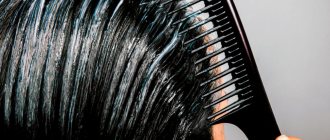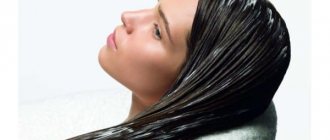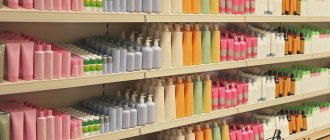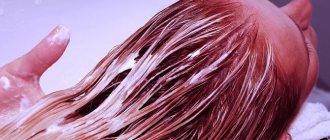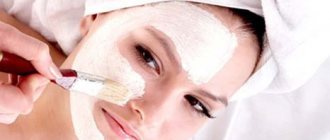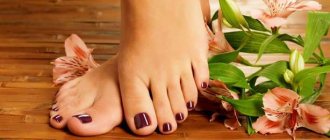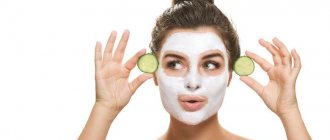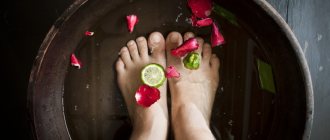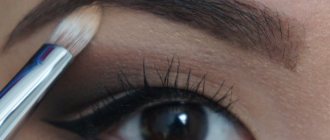Causes of increased oily scalp
The scalp, as well as the covering on other parts of the body, is equipped with sebaceous glands that produce oily secretions. This oily liquid is necessary to protect the epidermis from dryness, moisture loss, negative effects of climatic conditions, and pathogens.
During normal activity of the sebaceous glands, sebum forms a thin layer and does not damage the appearance of the skin and hair. But when the function of sebum secretion is impaired, excess fat accumulates, and this leads to the appearance of visible signs: rapid hair contamination, dandruff, itching.
There are many reasons for increased oily scalp. The activity of the sebaceous glands and the amount of secretion depends, first of all, on genetic predisposition. It is impossible to fight this.
In addition, there are a number of factors that cause increased fat production:
- Hormonal changes. It is observed in both girls and boys in adolescence, during puberty. Hormonal imbalance in women can be triggered by pregnancy, taking contraceptives, menopause, diseases of the endocrine system;
- Constant stressful situations, problems with the nervous system. Overexertion, lack of sleep, emotional disorders not only lead to dysfunction of the sebaceous glands, but also harm health and cause headaches;
- Poor nutrition. Strict diets, lack of necessary vitamins and minerals, and, on the contrary, excessive absorption of fatty, sweet, spicy foods provoke an increase in sebum production. It also causes diseases of the digestive system. This, in turn, will certainly “manifest” on the skin and hair;
- Climatic conditions. Prolonged exposure to heat and cold without a hat causes the sebaceous glands to activate, because the body strives to protect itself from temperature changes. This also happens with high humidity or dry air;
- Seborrhea, fungal infections. With these diseases, not only rapid greasy strands are observed, but also burning, itching, and hair loss;
- Improper and untimely care of the scalp and hair. Too frequent or infrequent washing, the use of chemical components (dyes, fixatives), thermal devices, aggressive shampoos damage the structure of the epidermis, and at the same time the sebaceous glands.
This reason is one of the most common.
Skin or hair that requires more care
The condition of the hairline is genetically determined in the body. You cannot change the thickness of the hair or its color. You can't change straight strands into curly ones. It is easy to influence the condition of the skin and reduce its oiliness.
With proper care for thin, oily curls at home, they will look better. It is important to choose a harmonious care system.
Many people make the standard mistake - they try to wash it until it’s squeaky clean with aggressive anti-greasy shampoos. You can't do this!
If the product completely removes all sebum, the glands begin to produce even more of it. This threatens to make the strands look greasy all the time.
You need to choose the right care
Another problem is that you can end up with broom-like curls. Sebum gives shine and smoothness, and if it is regularly cleaned aggressively, the hair shaft becomes rough and dry.
Dry strands are difficult to style, they do not shine and are unpleasant to the touch.
Why oily scalp is a problem
Is it possible to call increased oiliness of the scalp a problem? Certainly. First of all, the appearance “suffers”, and this is very important for a woman. Secondly, quickly greasy hair is just the “tip of the iceberg”, that is, a manifestation of hidden and much more serious problems in the body. Of course, if we are not talking about sloppiness and uncleanliness. The woman carefully monitors the cleanliness of her strands, washes them, nourishes them with the help of masks, and the curls still look as if they were rinsed in oil. This means that the cause of this may be a disease.
Whatever the reason that provoked the excessive production of sebum, the “clinical picture” of such a manifestation will be unpleasant:
- Literally a few hours after washing, the hair becomes sloppy again. They become saturated with a large amount of sebum, and dust sticks to oily strands;
- The oily liquid causes the hair to stick together, become heavy, and lose its volume and silkiness;
- Excess fat clogs the pores, making it difficult for oxygen to reach the follicles. The root bulbs weaken and cannot properly hold the hair, and this leads to hair loss. There may even be patches of baldness;
- Excess fat prevents the supply of nutrients, important processes in the layers of the dermis are inhibited;
- Constant “companions” of oily skin are dandruff and itching;
- Overactive sebaceous glands combined with a possible bacterial infection can lead to seborrhea.
Isn't this all a problem?
Rules for hair and head care to reduce oiliness
Some people think that getting rid of oily scalp is difficult and, moreover, almost impossible. This is wrong. Of course, if it is neglected, it will take more time and money. Treatment for increased fat content should begin as early as possible.
Activities must be carried out comprehensively and continuously:
- The first thing you need to start with is nutrition . You need to reconsider your diet and your eating habits. You will need to give up fried, fatty, smoked, and sweet foods, in particular pastries and chocolate. All these “goodies” should be replaced with fresh fruits and vegetables, dairy products, eggs, and cereals. And also take multivitamin medications.
- Getting rid of bad habits will have a beneficial effect on the overall health of the body and on the normalization of the sebaceous glands in particular. Nicotine and alcohol have a depressing effect on metabolic processes and lead to oxygen starvation;
Washing your hair is easy. But only at first glance. If the scalp suffers from excess sebum, then care should be delicate. And most importantly, special cosmetic and hygiene products will be required for washing.
the washing up
There is no need to wash your hair every day; this must be done as it gets dirty (about once every 3 days). The more often you wash off fat, the more it will be produced. For such procedures, water should be used that is soft and not hot, preferably at room temperature. Hot water further activates the secretion of the sebaceous glands.
Lose weight without denying yourself your favorite foods! Eat and lose weight! Find out how! >>
Now the main aspect is the choice of shampoo. To cleanse your curls in this situation, you will need a neutral shampoo, free of sulfates, silicone and parabens. There is no need to buy a 2 in 1 combination product (that is, shampoo and conditioner). There is quite a large selection of special shampoos for oily hair from the world's leading manufacturers.
The detergent is applied to the skin and hair roots, after which the head is massaged, the shampoo is distributed along the entire length of the hair threads.
If dandruff is present, then you need to choose a treating shampoo. It should not be used often, however, such products destroy pathogenic flora, killing beneficial microorganisms.
The shampoo needs to be changed periodically, but not often. Long-term use of one product leads to addiction, and frequent changes lead to stress. The detergent is changed once every 2 months.
And one more “highlight” - if you have oily hair, you can’t wash your hair at night. While the body is resting, the sebaceous glands “work hard.”
When there is no time to wash your hair, you can use dry shampoo. These products are presented in the form of a spray that sprays tiny powder particles that absorb excess oil. Your hair will look neat again. But you can’t often resort to this “shampoo”. It will not replace washing your hair. This method is used only in an emergency situation.
Rinse
Finish washing your hair by thoroughly rinsing the strands. For this, the best option would be to use acidified water (1 tablespoon of apple cider vinegar or lemon juice per 1 liter of water).
You can also use decoctions and infusions of medicinal plants (chamomile, nettle, calendula, birch, oak bark) as a rinse. Natural components have an anti-inflammatory effect. It is better to avoid store-bought balms and conditioners.
Drying, combing, styling
After washing and rinsing, you should just pat your hair dry with a towel, do not rub it thoroughly. You should also not use a hairdryer. Let the curls dry naturally.
Lose weight without denying yourself your favorite foods! Eat and lose weight! Find out how! >>
Do not comb wet hair. When combing, try not to let the brush come into contact with the scalp. The comb must be washed thoroughly and regularly; particles of sebum may remain on it, which will spread throughout the hair.
During the treatment course you will have to stop using the following things:
- Metal accessories (bobby pins, hairpins, hairpins);
- Hair dye;
- Thermal devices (irons, curling irons);
- Tight elastic bands.
If changing your diet and implementing proper care have not brought a positive result, then you should contact a trichologist and undergo an examination at the clinic for the presence of diseases that provoke malfunction of the sebaceous glands.
Only after eliminating these causes can we hope to successfully get rid of excess fat. In such cases, the specialist recommends undergoing complex hormonal therapy, treatment of pathologies of the digestive system, and the prescription of medicinal antifungal drugs.
What and how to wash oily hair
There are special shampoos designed for oily hair. After their use, the hair remains fresh longer, since certain components in such shampoos reduce the activity of the sebaceous glands. These shampoos are not cheap, so before purchasing them you should consult with specialists. We recommend paying attention to brands such as L'Oreal, Kerastase or Cutrins.
However, it is not always advisable to buy a special shampoo. You can almost always get by with a simple mild baby shampoo for daily use.
When washing oily hair, it is advisable to adhere to certain rules:
- Firstly : you should not use a large amount of shampoo.
- Secondly : shampoo should be applied only to the roots of the hair.
This will get rid of excess fat at the roots, and distribute the remaining fat evenly along the entire length of the hair. Thanks to these two simple rules, your hair will stay clean and fresh longer!
Besides:
- It is best to avoid . And special conditioners for oily hair do not need to be applied to the roots.
- Herbal rinses (for example, from oak bark or using a decoction of eucalyptus leaves) will help normalize the functioning of fat cells in the scalp.
- Homemade herbal masks effectively contribute to this Linden leaves, chamomile flowers, eucalyptus, and mustard are often used in such masks.
- Oily hair usually does not require additional moisture. But to give them extra silkiness, you can use essential oils diluted in minimal quantities in water. This product is applied to the hair by spraying through special bottles or a spray bottle.
Homemade recipes to reduce fat content
Traditional medicine, prepared at home using natural products, very effectively combats the problem of excessive oily skin and hair. They do not contain chemical components. There is always the opportunity to diversify caring mixtures and select them based on your own preferences.
Scrubs
The cleansing procedure with a scrub should be carried out 1-2 times every 7 days before washing your hair. The abrasive particles of the scrubbing product should not be large; movements during application should be done gently.
Recipe 1
- Sea salt (fine) – 1 spoon
- Essential oil – 3-4 drops
- Hair balm – 2 spoons
Mix all the ingredients, wait 3-4 minutes until the salt dissolves slightly (its edges will not be so sharp and will not injure the scalp). Then apply to the skin with circular massage movements for 2-3 minutes, keep on your head for the same amount of time and rinse.
Recipe 2
- Liquid honey – 1 spoon
- Ground natural coffee (or coffee grounds) – 2 tablespoons
- Essential oil (or vegetable oil) – 0.5 teaspoon
Candied honey should be held over steam or melted in a water bath, add the remaining ingredients to it, and mix. Use the same as in the previous recipe.
Rinse aids
Recipe 1
- Warm water – 1 l
- Lemon juice – 1 spoon
If lemon juice is replaced with granulated acid, then you need to take 2 times less of it. Add a citrus product to the water, mix and rinse your hair after washing. You can wipe a clean scalp with this solution by soaking a cotton pad in it.
If there is no lemon juice, then the rinse aid is prepared using 9% vinegar, take 1 spoon of acidic liquid.
Recipe 2
- Hot water – 1 glass
- Collection of medicinal herbs – 2-3 spoons
- Warm water – 2 l
First, prepare an infusion from the herbs and boiling water in the traditional way: pour in and leave for 15-20 minutes. Strain the medicinal liquid and add to the rinse water. Or use to rub directly into the scalp. For the herbal mixture, burdock, St. John's wort, string, celandine, chamomile, calendula, and nettle are suitable.
Lose weight without denying yourself your favorite foods! Eat and lose weight! Find out how! >>
Masks against oily hair and skin
Scalp masks are not used daily, but 1-2 times every 6-7 days. Their action should not be too aggressive, causing burning and itching. The mixtures are applied before washing your hair, but not before going to bed.
Their duration of action is from 15 to 25 minutes.
"With mustard"
- Raw egg – 1 pc.
- Vegetable oil – 1 spoon
- Mustard (dry powder) – 2 tablespoons
- Warm water – 2 spoons
Dilute the mustard with water to form a liquid paste, add the remaining ingredients and mix thoroughly. Apply a thick layer to the scalp without rubbing. You can wear a scarf or plastic cap on top. Keep it on for 30-40 minutes, but if you feel a strong burning sensation, the composition should be washed off earlier. Apply the mask once a week.
"With lemon and oils"
- Lemon juice – 1 spoon
- Olive oil – 1 spoon
- Castor oil – 1 spoon
Combine all products in equal quantities and apply to hair roots and skin half an hour before washing.
"With oils"
- Vegetable oil – 2 tablespoons
- Essential oils – 4-5 drops
To prepare this composition, take a base oil - olive, almond, burdock, flaxseed or other vegetable oil, add essential oils, if one, then 5 drops, if a mixture, then 1-2 drops of each.
The best oily liquids to combat excess fat: ylang-ylang, grape seed, jojoba, wheat germ. Esters can be replaced with the same amount of oil solution of vitamins “A” and “E”.
"With sour cream and castor oil"
- Honey – 1 spoon
- Natural sour cream – 1 spoon
- Lemon juice – 1 teaspoon
- Castor oil – 1 teaspoon
- Garlic – 2 cloves
Chop the garlic and combine with other ingredients; if desired, add a few drops of freshly squeezed aloe juice. Apply to the scalp an hour before washing.
Tinctures for rubbing into the scalp
"With pomegranate peel"
- Peel of 1 fresh pomegranate
- Boiled water – 1 glass
Pour liquid over the peel and leave for 1 hour, strain and treat the skin with the infusion using a soft cloth or cotton pad half an hour before washing.
Instead of regular boiling water, you can take a strong hot decoction of parsley. It is prepared in advance in a 1:2 ratio (for 1/2 cup of parsley, 1 cup of water).
"With alcohol"
- Medicinal mixture – 1 glass
- Vodka (or alcohol) – 0.5 l
A mixture of medicinal herbs, crushed oak bark, birch buds, rose hips are placed in a container, filled with vodka and tightly closed with a lid. All this must be put in a dark, cool place and left for 10-12 days, shaking occasionally. Then strain and use as directed. Can be stored in the refrigerator, but no more than 2 months.
